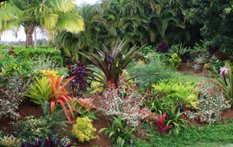Tropical Garden Design: Planning Your Exotic Retreat
Dramatic structure and vibrant colors are the foundation for
tropical garden design.
The desired outcome of a successful design is creating a space that is
both sustainable and visually striking.
With proper planning, planting, and care, you will create a tropical
garden paradise to enjoy at your leisure.
Choosing a Tropical Garden Location
The first step in creating your tropical garden design is to choose an ideal location. Tropicals thrive in warmth, humidity, and sunny
conditions. Keep this in mind while you contemplate possible garden
sites. For optimal results, consider the following factors:
ideal location. Tropicals thrive in warmth, humidity, and sunny
conditions. Keep this in mind while you contemplate possible garden
sites. For optimal results, consider the following factors:Sunlight – Sunlight requirements differ among species. On the flip side, some species require a fair amount of shade for optimal growth.
Soil Drainage – Soil containing sand drains very fast, while soil full of clay drains slowly. If you test the soil prior to planting, you can identify and correct issues.
Water Location – Do you have a sprinkler system, or will you be watering the garden using a hose?
Soil Quality – Ideal pH is in the range of 6.5 to 7.2. Soil test kits can be purchased from garden centers or online. If test results determine pH levels need to be adjusted, sulfur will reduce acid, and lime will reduce alkaline. Retest soil in two weeks to determine if further adjustments are required.
Principles of Garden Planning
The elements of design determine how a space is perceived. Rely on these artistic principles throughout your tropical garden planning process.Line – Creates a sense of direction as well as a sense of movement.
Form – Will aid in dividing and defining spaces in you garden.
Texture – Adds drama and interest, as well as evokes emotional responses.
Light – Changes the way colors look and how they work together.
Scale – The relationship of one object to another.
Pattern – The duplication of shapes in order.
Balance – Achieved when the elements on each side of a real or imaginary axis are equal.
Contrast – Emphasizes the difference between a plant or an object and its surroundings.
Color – A powerful tool that can be used to accomplish varying effects.
Unity – The harmonious blending of elements for a well balanced tropical garden design.
Tropical Garden Plants for
Your Garden Design
Layering tropicals, including trees, shrubs, flowers and ornamental
grasses will duplicate an island paradise.Trees – Provide background and add shade to your garden. Also serve as focal points.
Shrubs – Add support and framework to overall tropical garden design. Shrubs can also be used to create privacy.
Flowers – Provide color, scent, and visual dimension.
Ornamental Grasses – Creates visual interest by adding texture to you design. Grasses also add color when flowers are not blooming.
Cold Climate Solutions
You can create a design for colder climates by using the following techniques:- Plant tropical look-a-likes.
- Overwinter plants by bringing them indoors for the winter.
- Plant hardier tropical plants.
- Try new hardy tropical cultivars as they become available.
Related Gardening and Garden Design Information
Hand Garden Tools – Gardening EssentialsGarden Water Feature – Peace and Tranquility





